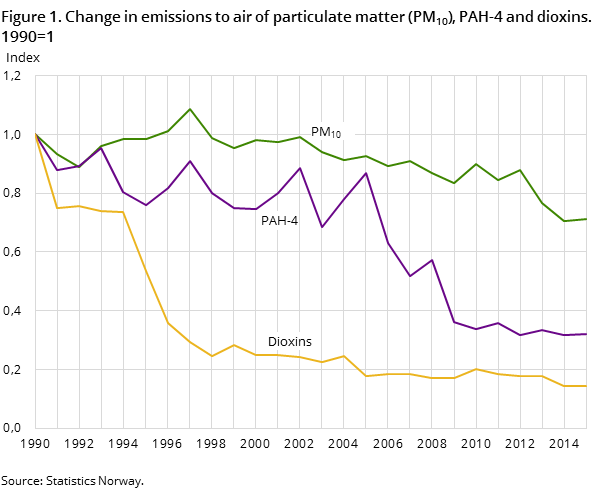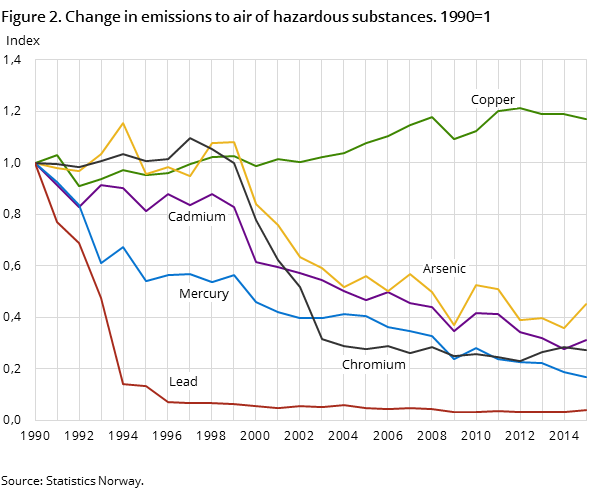Small changes in emissions of hazardous substances
Published:
There were comparatively small changes in emissions of hazardous substances from 2014 to 2015. Some large increases are due to casual annual variations, while there was a substantial 10 per cent drop for mercury.
- Full set of figures
- Emissions to air of hazardous substances and particulate matter
These statistics comprise only emissions to air.
Decrease in most emissions since 1990
Emissions of hazardous substances have been reduced considerably since 1990, except for copper, which has increased in the same period. The cause of the decrease since 1990 is primarily reduced emissions within manufacturing and mining. Cleaning measures, changes in production procedures and lower activity in some industries have all resulted in reduced emissions. Many hazardous substances are sensitive to, among other things, measuring uncertainty. This implies that variations between single years not should be emphasized too much, while the trend over a longer period says more about the emission development. For several heavy metals it is a national target to end the emissions by 2020. Internationally, Norway has an obligation to reduce emissions of selected hazardous substances compared with 1990.
Small increase in emissions of particulate matter
Emissions of particulate matter (PM10) amounted to 37 100 tonnes in 2015. This is 1 per cent more than in 2014, but less than in all other years in the period from 1990. Almost half of the emissions of particulate matter (PM10) in 2015 came from wood burning. The wood consumption increased by 6 per cent from 2014 to 2015, which may be connected with the fact that 2015 was a somewhat cooler year than 2014, which was record warm. Emissions from manufacturing and mining amounted to 7 700 tonnes, or 21 per cent of the emissions of particulate matter in 2015. These emissions have been almost halved since 1990.
Minor increase in PAH-4 emissions
The estimated PAH-4 emissions in 2015 amounted to 6.4 tonnes, which is an insignificant increase from 2014. Process emission from manufacturing of aluminium is the most important emission source for PAH-4, and these emissions were responsible for 48 per cent of the total in 2015. Since 1990, PAH-4 emissions from aluminium production have been reduced by 79 per cent. Road traffic (including wear on roads, tyres and brakes) is the second most important source for emissions of PAH-4, and contributed with 24 per cent of the emissions in 2015. In 2015, 18 per cent of the PAH-4 came from wood burning.
Stable emissions of dioxins
The emissions of dioxins in 2015 have been estimated to 17 grams, the same as the year before. Wood burning in households is now the most important source for emissions to air of dioxins in Norway, and was responsible for one third of the emissions in 2015. From 1990, the dioxin emissions have been reduced by 86 per cent, mainly due to lower emissions from mines and metal-working industry, which were the most important sources at that time.
Somewhat less mercury, chromium and copper
The emissions of mercury amounted to 0.2 tonnes in 2015, which is 10 per cent less than the previous year. Mercury emissions were 83 per cent lower in 2015 than in 1990, particularly due to a 93 per cent reduction in the metal-working industry, which was by far the most important source in 1990. Regulation of mercury in products has also led to a major reduction in emissions from this source. Today, there is no dominant source for emissions to air of mercury, but the metal-working industry, navigation and fishing are the largest contributors.
In 2015, 3.1 tonnes of chromium were emitted. This is 4 per cent less than in 2014. Combustion in the chemical and mineral industries is now the dominant source of chromium emissions to air in Norway. These industries were responsible for 45 per cent of the emissions in 2015. In 1990, process emissions from the metal-working industry were the dominant source for chromium. Since 1990, these emissions have been reduced by 97 per cent.
Estimated copper emissions in 2015 were 28.1 tonnes. This is 1 per cent less than the year before. Emissions from brake blocks are the dominant source for emissions to air of copper, and these emissions amounted to 52 per cent of the total in 2015. Emissions from this source have grown by more than 50 per cent since 1990. As the sum of other emissions has been at the same level throughout the entire period, copper emissions are the only emissions of hazardous substances that are higher in 2015 than in 1990. In 2015, total copper emissions had grown by 17 per cent from 1990.
More lead and cadmium
Estimated emissions to air of lead in 2015 amounted to 7.2 tonnes, which is 23 per cent more than in 2014. From 1990, the lead emissions have been reduced by 96 per cent, mainly due to the phasing out of leaded petrol in the early 1990s. The increase from 2014 to 2015 is due to a doubling in the sales of aviation petrol. Even though these sales are minor compared to the total sales of petroleum products in Norway, the emissions of lead from these energy goods are so large and the total lead emissions in Norway today so small, that such an increase has a strong effect on the figures.
Emissions to air of cadmium totalled 0.5 tonnes in 2015, and the emissions were 12 per cent higher than the preceding year. Wood burning in private households is now the most important source for emissions of cadmium to air in Norway, and contributed with 21 per cent of the total emissions in 2015. The emissions of cadmium were 69 per cent lower in 2014 than in 1990, largely due to a significant reduction in emissions from the metal-working industry.
Contact
-
Kristin Aasestad
-
Trond Sandmo
-
Statistics Norway's Information Centre


